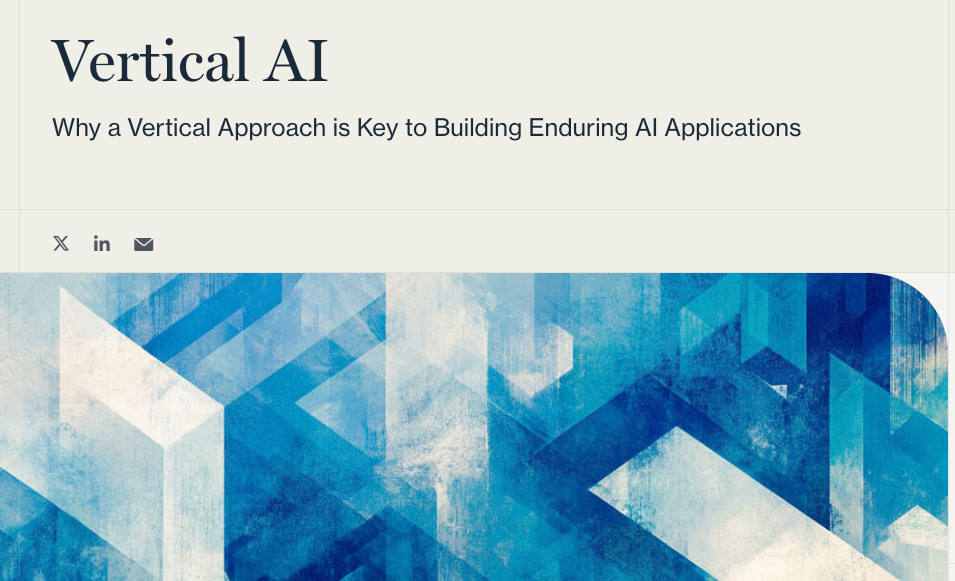The Vertical AI Report: Issue #1
The future of AI is Vertical, and that's not just a catchy tagline
It might sound like a bold statement - the future of AI is vertical, but I have strong conviction that it is the direction the world is moving, and faster than most people think. Of course, I didn’t come up with this awesome tagline, the credit belongs most likely to Bessemer Ventures, who wrote a post with this title.
Bessemer is famous for building one of best (if not the best) Vertical Saas investment portfolios on the planet. They saw the opportunity in companies like Shopify back in 2010 when most investors thought Vertical Saas meant markets that were just too small to be interesting.
Fast forward to today and Vertical Saas is one of the hottest areas of venture investment and has created a nice cozy home for many of the unicorns we all know, love, and use today.
So it shouldn’t be that shocking to anyone that as AI has quickly become the focus for software companies, just like Saas did over a decade ago, that Vertical AI should find its way into the spotlight.
Of course it’s not just Bessemer that is investing in this space. In fact, Greylock put out an article back in December of 2023 titled Vertical AI.
And while Greylock doesn’t specifically say “the future of AI is vertical,” they essentially say it, just in different words, in this article.
What I find interesting about this article from Greylock is their note that Vertical Saas has likely been redefined over the years and now is more likely just called Vertical Software.
Yet there are still many markets underserved by Vertical SaaS: foundational industries with intrinsic barriers to technological disruption (e.g. unstructured data, constrained TAMs, slow sale cycles, low annual contract values, and tricky incumbents), and sectors that are either just emerging or undergoing a major transformation (e.g. the electrification of energy.)
But now, two key developments have made it possible to build software that serves these outliers: 1) the rise of artificial intelligence that can tackle unstructured data and 2) the redefinition of Vertical SaaS as Vertical Software. (Source - Greylock)
I think Greylock does a great job identifying the opportunity here for founders - finding markets that are underserved by Vertical Saas. Personally, I can think of a dozen legacy Vertical Saas companies that will need to either start leveraging AI, or be prepared to be unseated by a startup that does.
In Bessemer’s article, they do a great job of digging into exactly how Vertical AI came to life, and where the opportunity is, and yes - this is a foundational change that’s still relatively nascent, dating back only to 2023.
The meteoric rise of these businesses over the past 15+ years and the advancements in AI during that same period has set the stage for an exciting new development in the vertical software landscape: Vertical AI. This all came to a head in 2023, when we saw a new class of LLM-native applications harnessing novel business models and AI capabilities in order to serve functions and even entire industries that didn’t meaningfully benefit from the previous wave of vertical software.
Unlike their predecessors, these vertical AI applications are able to target the high cost repetitive language-based tasks that dominate numerous verticals and large sectors of the economy — such as legal, healthcare, and finance — that were largely out of bounds for legacy vertical software. (Source - Bessemer Ventures)
Bessemer is predicting that we’ll see at least five Vertical AI companies with an ARR of $100M+ within the next two to three years. While that’s a bold prediction, it isn’t coming from someone just putting their finger in the air, it’s coming from one of the top VC firms on the planet that studies these trends, and the data behind them, more than just about anyone else.
In their article, Bessemer highlights three key areas where Vertical AI startups can find opportunities:
Expanding TAMs - finding niche categories that would typically have a TAM too small for Vertical Saas companies, but have much bigger TAMs for Vertical AI companies. the TAM is bigger for Vertical AI companies because they enable companies in their niche to acquire more customers faster, thereby increasing the TAM of the market because of their product.
Unlock new functions and verticals - while you might think software has already eaten the world, it hasn’t yet. Some markets that have yet to be penetrated by Vertical Saas, will likely see a tipping point with Vertical AI.
Provide unprecedented value - there are a lot of jobs done today by humans that are limited by how much data a human can realistically digest and process, AI can dramatically streamline workflows here in ways humans, even humans with automation, can’t compete with.
One of the questions that I know is on most people’s minds reading this is defensibility and moat. Aren’t so many of these new AI companies just wrappers on top of existing AI models? While some are, and yes, those might not have great defensibility, many are infusing new datasets into these models, creating their own proprietary models that are getting smarter by the second, giving them not just a head start but a meteoric lead over any future incumbents.
That being said, I think one of the biggest challenges for VCs will be to determine which startups are actually leveraging unique data and building their own proprietary models, and who is really just using LLMs out-of-the-box. I believe a new, deeper level of due diligence will be required than ever before to truly understand what’s going on under-the-hood. For VCs who don’t do this diligence, there will definitely be a real risk of investing in a startup that is more marketing hype than true, differentiated, AI.
In The Vertical AI Report, I’m going to be doing my best to bring a data-driven approach to reporting on the development of the Vertical AI space, and hopefully from a little different perspective. You see, I am not a journalist, and I’m not a VC. I’m an engineer, and the co-founder and CTO of a Vertical AI startup. Of course, I’m not saying there’s anything wrong or inaccurate about journalists and VCs covering Vertical AI, they have plenty of expertise to share and a lot more data than I do in many cases. What I hope to offer is a different perspective, one from someone building and growing a Vertical AI startup and dealing with the ups and downs that come with the complexities of being a founder in this emerging space.
I’m also biased towards learning from other founders who are in the weeds here with me, so I will also be trying to get as many Vertical AI founders as I can to share their insights, from the inside, with all of you. I don’t quite know where this is going, and as you’ve probably noticed, I’m not charging any money for this Substack right now. Like I said above, I’m not a journalist, I don’t write for a living, I run a Vertical AI startup for a living so all I can do is share my perspective, and hopefully provide some nuggets that you can’t find anywhere else.
To kick things off I’ll be writing weekly, this is week one. Thanks for reading, and if you enjoyed this, please share it with others who might as well!





